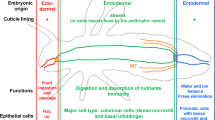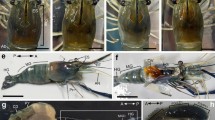Abstract
Adult and 3-week-old juvenileFasciola hepatica were examined for the presence of the cytoskeletal protein actin. Techniques of direct fluorescence using fluorescein isothiocyanate (FITC)-phalloidin and of indirect immunofluorescence using a monoclonal anti-actin antibody (MAA) demonstrated actin in the testes, sub-tegumental and gut musculature, tegumental cell bodies and tegumental spines. In contrast, polyclonal anti-actin antibody (PAA) revealed immunostaining only in the vitellaria. Effective removal of the tegument with 1% (w/v) sodium dodecyl sulphate (SDS) was confirmed by scanning electron microscopy (SEM), and this enabled immunoblotting of whole fluke and tegumental fractions with and without spines. Whole fluke fractions produced three bands corresponding to molecules exhibiting relative molecular weights of 43, 28 and 15 kDa, respectively, whereas the tegumental fraction with spines revealed a single band corresponding to 15 kDa in size. The fraction without spines displayed no bands. The present study localised actin in a number of different tissue types within the liver fluke. Using MAA, three forms of actin have been identified in the whole fluke and a single one in the tegumental spines.
Similar content being viewed by others
References
Abbas MK, Cain GD (1987) Actin and intermediate-sized filaments of the spines and cytoskeleton ofSchistosoma mansoni. Parasitol Res 73:66–74
Abbas MK, Cain GD (1989) Analysis of isoforms of actin fromSchistosoma mansoni by two-dimensional gel electrophoresis. Parasitol Res 76:178–180
Allison AC, Davies P, DePetris S (1971) Role of contractile microfilaments in macrophage movement and endocytosis. Nat New Biol 232:153–155
Anderson HR, Fairweather I (1988) Scanning electron microscopic observations of juvenile flukes following treatmentin vitro with the deacetylated (amine) metabolite of diamphenethide (DAMD) Int J Parasitol 18:827–837
Burgess TL, Kelly RB (1987) Constitutive and regulated secretion of proteins. Annu Rev Cell Biol 3:243–293
Campos A, Bernard P, Fauconnier A, Landa A, Gómez E, Hernandez R, Willms K, Laclette JP (1990) Cloning and sequencing of two actin genes fromTaenia solium (Cestoda). Mol Biochem Parasitol 40:87–94
Carter SB (1972) The cytochalasins as research tools in cytology. Endeavour 31:77–82
Cohen C, Reinhardt B, Castellani L, Norton P, Stirewalt M (1982) Schistosome surface spines are “crystals” of actin. J Cell Biol 95:987–988
Coons AH, Leduc EH, Connolly JM (1955) Studies on antibody production. I. A method for the histochemical demonstration of specific antibody and its application to a study of the hyper-immune rabbit. J Exp Med 102:49–60
Cooper JA (1987) Effects of cytochalasin and phalloidin on actin. J Cell Biol 104:1473–1478
Davis AH, Blanton R, Klich P (1985) Stage and sex specific differences in actin gene expression inSchistosoma mansoni. Mol Biochem Parasitol 17:289–298
Erasmus DA (1967) The host-parasite interface ofCyathocotyle bushiensis Khan, 1962 (Trematoda: Strigeoidea). II. Electron microscope studies of the tegument. J Parasitol 53:703–714
Estes JE, Selden LA, Gershman LC (1981) Mechanism of action of phalloidin on the polymerisation of muscle actin. Biochemistry 20:708–712
Fairweather I, Anderson HR, Baldwin TMA (1987)Fasciola hepatica: tegumental surface alterations following treatment in vitro with the deacetylated (amine) metabolite of diamphenethide. Parasitol Res 73:99–106
Forte TM, Machen TE, Forte JG (1975) Ultrastructural and physiological changes in piglet oxyntic cells during histamine stimulation and metabolic inhibiton. Gastroenterology 69:1208–1222
Hanna REB (1980a)Fasciola hepatica: glycocalyx replacement in the juvenile as a possible mechanism for protection against host immunity. Exp Parasitol 50:103–114
Hanna REB (1980b)Fasciola hepatica: an immunofluorescent study of antigenic changes in the tegument during development in the rat and the sheep. Exp Parasitol 50:155–170
Hanna REB, Trudgett AG (1983)Fasciola hepatica: development of monoclonal antibodies and their use to characterize a glycocalyx antigen in migrating flukes. Parasite Immunol 5:409–425
Lacey E (1988) The role of the cytoskeletal protein, tubulin in the mode of action and mechanism of drug resistance to benzimidazoles. Int J Parasitol 18:885–936
Lackie JM (1986) Cell movement and cell behaviour. Allen and Unwin, London
Laemmli UK (1970) Cleavage of structural proteins during the assembly of the head of bacteriophage T4. Nature 227:680–685
MacGregor AN, Shore SJ (1990) Immunostaining of cytoskeletal proteins in adultSchistosoma mansoni. Int J Parasitol 20:279–284
Matsumoto Y, Perry G, Levine RJC, Blanton R, Mahmoud AAF, Aikawa M (1988) Paramyosin and actin in schistosomal teguments. Nature 333:76–78
McGuire J, Moellmann G (1972) Cytochalasin B: effects on microfilaments and movement of melanin granules within melanocytes. Science 175:642–644
Mohun TJ, Brennan S, Dathan N, Farman S, Gurdon JB (1984) Cell type-specific activation of actin genes in the early amphibian embryo. Nature 311:716–720
Otey CA, Kalnoski MH, Bulinski JC (1987) Identification and quantification of actin isoforms in vertebrate cells and tissues. J Cell Biochem 34:113–124
Pearson AGM, Fincham AG, Waters H, Bundy DAP (1985) Differences in composition betweenFasciola hepatica spines and cestode hooks. Comp Biochem Physiol [B] 81:373–376
Pollard TD (1986) Assembly and dynamics of the actin filament system in nonmuscle cells. J Cell Biochem 31:87–95
Rappaport R (1986) Establishment of the mechanism of cytokinesis in animal cells. Int Rev Cytol 105:245–281
Reger JF (1976) Studies on the fine structure of cercarial tail muscle ofSchistosoma sp. (Trematoda). J Ultrastruct Res 57:77–86
Salmon ED (1989) Cytokinesis in animal cells. Curr Opin Cell Biol 1:541–547
Skuce PJ, Fairweather I (1990) The effect of the hydrogen ionophore closantel upon the pharmacology and ultrastructure of the adult liver fluke,Fasciola hepatica. Parasitol Res 76:241–250
Smyth JD, Halton DW (1983) The Physiology of Trematodes. Cambridge University Press, Cambridge
Stitt AW, Fairweather I (1991)Fasciola hepatica: the effect of the microfilament inhibitor cytochalasin B on the ultrastructure of the adult fluke. Parasitol Res (in press)
Stitt AW, Fairweather I, Johnston CF (1991)Fasciola hepatica: disruption of spermatogenesis by the microfilament inhibitor cytochalasin B. Parasitol Res 77:123–128
Threadgold LT (1968) The tegument and associated structures ofHaplometra cylindracea. Parasitology 58:1–7
Towbin H, Staehelin T, Gordon J (1979) Electrophoretic transfer of proteins from polyacrylamide gels to nitrocellulose sheets. Procedure and some applications. Proc Natl Acad Sci USA 76:4350–4354
Verderame M, Alcorta D, Egnor M, Smith K, Pollack R (1980) Cytoskeletal F-actin patterns quantitated with fluorescein isothiocyanate-phalloidin in normal and transformed cells. Proc Natl Acad Sci USA 77:6624–6628
Vial JD, Garrido J (1976) Actin-like filaments and membrane rearrangement in oxyntic cells. Proc Natl Acad Sci USA 73:4032–4036
Wessels NK, Spooner BS, Ash JF, Bradley MO, Luduena MA, taylor EL, Wrenn JT, Yamada KM (1971) Microfilaments in cellular and developmental processes. Science 171:135–143
Wray W, Boulikas T, Wray VP, Hancock R (1981) Silver staining of proteins in polyacrylamide gels. Anal Biochem 118:197–203
Wulf F, Deboben A, Bautz FA, Faulstich H, Wieland T (1979) Fluorescent phallotoxin, a tool for the visualization of cellular actin. Proc Natl Acad Sci USA 76:4498–4502
Author information
Authors and Affiliations
Rights and permissions
About this article
Cite this article
Stitt, A.W., Fairweather, I., Trudgett, A.G. et al. Localisation of actin in the liver fluke,Fasciola hepatica . Parasitol Res 78, 96–102 (1992). https://doi.org/10.1007/BF00931648
Accepted:
Issue Date:
DOI: https://doi.org/10.1007/BF00931648




